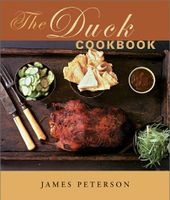🔥 Try our grilling cookbooks and save 25% on ckbk membership with code BBQ25 🔥
Using Every Part of the Duck
Duck Fat
Published 2003
To render duck fat, save the skin from raw ducks—I save it in the freezer, tightly wrapped, until I have enough to make a project out of it, but it’s worth saving even the skin from one duck carcass—and chop it fine, either by hand or in a food processor. Put it in a heavy-bottomed pot and cook it over medium heat until clear. When small pieces of skin left in the fat begin to turn brown and the fat itself is perfectly clear, usually after 1 to 2 hours, depending on the quantity, it’s ready to strain. (Be very careful not to overcook the fat or it will lose its flavor. It’s better to err in the direction of undercooking.) Strain the fat into containers with tight-fitting lids (I use containers saved from take-out food), let it cool, and refrigerate for a month or two or freeze it indefinitely. (For directions on saving the fat that duck breasts render during sautéing).
Become a Premium Member to access this page
Unlimited, ad-free access to hundreds of the world’s best cookbooks
Over 160,000 recipes with thousands more added every month
Recommended by leading chefs and food writers
Powerful search filters to match your tastes
Create collections and add reviews or private notes to any recipe
Swipe to browse each cookbook from cover-to-cover
Manage your subscription via the My Membership page
Part of
Advertisement
Advertisement


